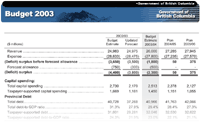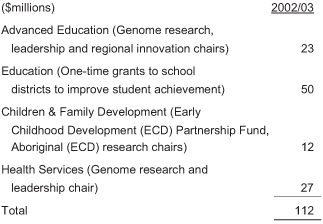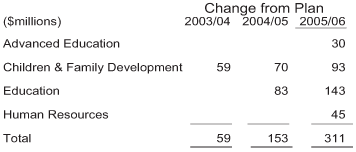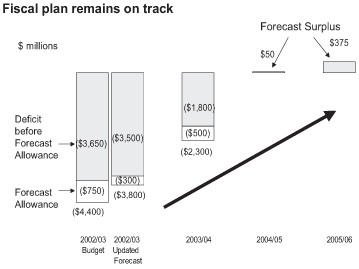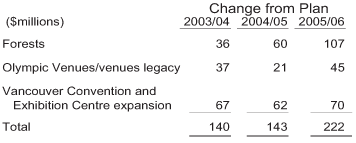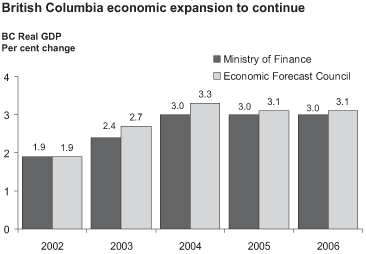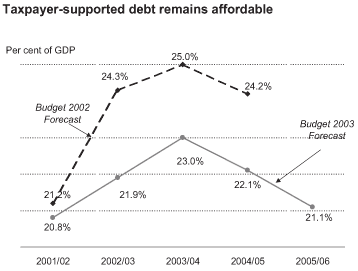 |
|
The government's fiscal plan to balance the budget beginning in 2004/05 remains on track. A $2.3 billion deficit is projected for 2003/04. This includes a $500 million forecast allowance to cushion against unexpected negative developments. Before this forecast allowance, the deficit is estimated to be $1.8 billion, the same as forecast a year ago. Surpluses of $50 million and $375 million are projected in 2004/05 and 2005/06. For 2002/03, the deficit is now forecast to be $3.8 billion, $600 million less than budget, including a reduced forecast allowance of $300 million. All ministries are expected to be on or under budget (excluding a one-time forest restructuring provision). Lower debt interest costs, lower employment assistance caseloads and other savings have freed up funds for key priorities including:
Prudent fiscal management and a growing economy will allow government to meet British Columbians' priorities in 2003/04 and beyond, and to fund school based programs (CommunityLink), the Child and Youth Mental Health Plan, additional grants to schools and other initiatives. While remaining within the bottom-line fiscal plan targets, additional new funding is allocated to the following social ministries:
Government is continuing to implement a strategy to build a strong, vibrant and competitive economy. Budget 2003 maintains:
Budget 2003 also includes specific targeted tax measures totalling $29 million by 2004/05 to further enhance the competitiveness of specific sectors including:
In addition to a $275 million provision in 2002/03 to assist the transition to a sustainable forestry sector, Budget 2003 provides new funds to open up B.C. to economic development:
A three-year transportation infrastructure plan will invest about $650 million raised from a 3.5 cent per litre increase in the provincial fuel tax, and will leverage an additional $1.7 billion from other partners, to expand and improve the provincial transportation system. Subsequent to core services and energy policy reviews, government policy now fosters opportunities for private sector investment in the energy and auto insurance sectors, and provides independently regulated rates for ICBC and BC Hydro.
Economic growth of 2.4 per cent is forecast for 2003, slightly lower than the independent Economic Forecast Council consensus. The B.C. economy is projected to expand at a rate of 3.0 per cent in 2004, 2005 and 2006. Revenue growth of 4.1 per cent is forecast in 2003/04,as increasing tax revenues and stronger natural gas royalties offset the impact of low water levels in the BC Hydro system. From 2003/04 to 2005/06, revenue grows an average 3.7 per cent per year. No additional federal health funding is included in the budget at this time. An estimated $1.3 billion over 3 years will be allocated to health care in the coming weeks once details of the First Ministers' Accord on Health Care Renewal are finalized. Government debt at the end of 2002/03 is forecast to total $37.3 billion, $3.5 billion less than budget. This results from a lower deficit, reduced capital spending and lower working capital requirements. This gain carries forward, reducing the debt interest costs for future generations of British Columbians. The key taxpayer-supported debt-to-GDP ratio is now expected to be much lower than forecast a year ago.
|
|||||||||||||||||||||||||||||||||||||||
|
||||||||||||||||||||||||||||||||||||||||
